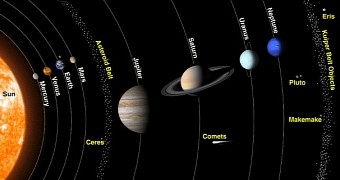An animation released by NASA scientists this past Monday, May 11, is said to be the closest and most detailed view yet of dwarf planet Ceres, an orb circling the Sun between Mars and Jupiter.
The animation comprises a series of images delivered by the agency's Dawn probe and taken from a distance of merely 8,400 miles (13,600 kilometers).
In a statement, NASA mission scientists explain that the resolution of these latest images produced by the Dawn spacecraft on May 3 and 4 is one of 0.8 miles (approximately 1.3 kilometers) per pixel.
Ceres appears to host ice on its surface
A view of Ceres obtained by NASA's Dawn probe earlier this year, on February 4, showed several odd-looking white spots on the surface of this dwarf planet.
At that time, the spacecraft was about 90,000 miles (145,000 kilometers) from the celestial body and so could not produce detailed images of these mysterious white spots.
The images obtained earlier this month, however, provide a clearer view of the bizarre features and show that they actually comprise many smaller spots.
True, researchers don't yet know what these spots on Ceres might be. Still, latest theories say that they are the result of sunlight hitting a reflective material on the orb's surface.
Judging by how bright the spots appear to be in the most recent images obtained by the Dawn spacecraft, it might be that this reflective material is good old ice.
“The intense brightness of these spots is due to the reflection of sunlight by highly reflective material on the surface, possibly ice,” said scientist Christopher Russell.
Dawn will soon move even closer to Ceres
NASA's Dawn probe left our planet in September 2007, when it was launched into space from the Cape Canaveral Air Force Station in Florida, US.
The space vehicle finally reached dwarf planet Ceres in this year's March, after having journeyed for more than 3.1 billion miles (4.9 billion kilometers) to meet with it.
When it was captured by Ceres' gravity and began orbiting it, the probe found itself some 38,000 miles (61,000 kilometers) away from its target.
NASA scientists say that, now that it has completed a first full circle of the celestial body, the Dawn spacecraft is steadily moving into a second and lower mapping orbit.
Once it settles into this second orbit, the probe will image the surface of the dwarf planet from an altitude of just 2,700 miles (4,400 kilometers).
Researchers expect that this second phase of its mission will allow the spacecraft to study Ceres' geography in further detail, maybe even zoom in on geological activity in its surface.

 14 DAY TRIAL //
14 DAY TRIAL //